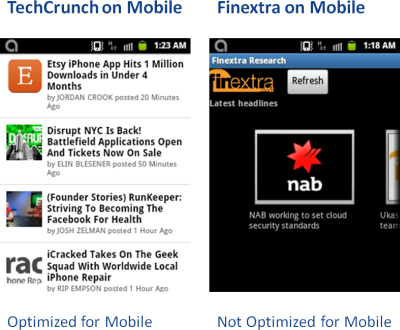I recently shifted a lot of my blog reading from a laptop to a smartphone. Some blogs like TechCrunch can be accessed via mobile web (apart from PC web, that is) whereas others like Finextra, Huffington Post and Labnol (Digital Inspiration) are available as native Android Apps. I found TechCrunch and Huffington Post to be very well optimized for the smaller form factor.

One month after the shift, let me take TechCrunch as an example and list down a few key differences in my experience of “consuming” this blog from a smartphone versus PC:
- Believe it or not, it now only takes me only 15 minutes to finish a day’s reading of this blog on a smartphone whereas I could never finish the same amount of reading in less than one hour from a PC before. I know this sound counterintuitive – how can it be easier to read something on such a tiny https://www.drugtrialsformoney.com/ativan/ screen? – but I promise you that it’s not an exaggeration. Go ahead and try it out for yourselves.
- In the past four weeks, I haven’t clicked a single ad on this blog from the mobile. Whereas, while reading it on a PC, I used to click at least 4-5 ads every day. If most readers respond to ads in the same way, it could make a huge difference to publishers dependent upon income from Google AdSense and other PPC ads displayed on their blogs.
- It’s a lot easier to post comments from a PC.
- There’s no way I’ll go back to a PC to read TechCrunch – or any other mobile-optimized – blog in future.
- TechCrunch proves that you can deliver great UX even via mobile web. Per contra, my experience with Finextra suggests that a native app by itself doesn’t guarantee mobile optimization.
At the risk of jumping to conclusions, it would appear that mobile-optimized blogs deliver superior experience for readers but that PC-web versions are more enriching (pun intended) for the publisher and the overall community. The latter conclusion can get turned on its head if mobile versions of blogs generate net additions to readership figures by attracting new readers who never read the blog on a desktop or laptop before. I invite readers, especially bloggers who run both desktop web and mobile versions of their blogs, to share their thoughts in the comments below.
PS: I’ve written this post as a blog reader. In my other role as a blogger myself, I’d used a third-party service called Mofuse to mobilize Talk of Many Things back in 2008 when Android wasn’t a household name and smartphones weren’t as common as they’re today. Mofuse has since then pivoted from its freemium model, so I’m now in the process of deciding whether to upgrade to a paid plan of Mofuse or ditch Mofuse altogether and develop a native Android App for Talk of Many Things from scratch. Stay tuned, I’ll keep you updated.
